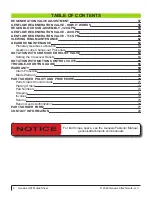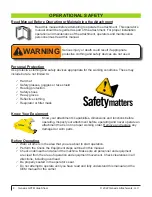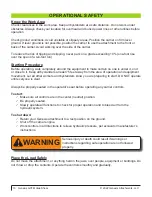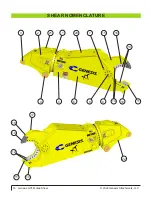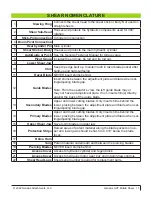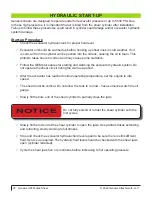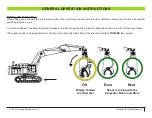
© 2022 Genesis Attachments, LLC
Genesis GXT Mobile Shear 19
SHEAR INSTALLATION
Preparation of the excavator prior to attachment delivery will make installation safer and
easier. Contact Genesis or your Genesis dealer for assistance.
Dual-Pump Flow
An excavator typically has two hydraulic pumps that supply oil to its main control valve, which
is usually separated into two halves. Combining the flow from both halves of the control valve is
called summating, thus achieving dual-pump flow to operate one circuit.
Summating is the preferred method of achieving maximum speed to an attachment. However,
interchanging the stick and bucket circuits may also substantially increase speed.
A bucket circuit is usually single-pump flow while a stick circuit is dual-pump flow. At times, adding
an auxiliary circuit spool to the stick circuit helps reduce back pressure in the system and speed
up jaw open and close.
In certain cases, the bucket and auxiliary circuits can be summated to achieve dual-pump flow,
depending on whether the bucket and auxiliary are on separate sides of the main valve and
whether the auxiliary circuit can be proportionally controlled by teeing into the bucket pilot control
circuit.
The auxiliary circuit must also be capable of proportionally controlling pump initiation on the
auxiliary side of the circuit. On many excavators, the auxiliary circuit is controlled by the flow
percentage set in the operating system. Because attachments take all the flow the pumps can
give them, when this percentage is reached, the pump will instantly turn on or off instead of
gradually increasing or decreasing, which can cause sharp, damaging spikes in the hydraulic
circuit.
If excavator circuits are electronically controlled, it may be necessary to reduce the spool shift and
pump initiation in the excavator software to take spiking out of the circuit when changing
attachment cylinder direction from full extend or full retract.
On excavators with full hydraulic spool piloting, install a flow control into the pilot lines between
the joystick and spools. The flow control can then be adjusted to slow the pilot oil flow to the spool,
which in turn slows how the spool shifts and the pumps stroke up.


